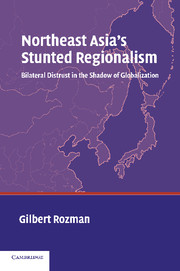Book contents
- Frontmatter
- Contents
- Acknowledgments
- Map
- Northeast Asia's Stunted Regionalism
- 1 Introduction: The Challenge of the Northeast Asia Region
- 2 Exiting the 1980s: Cold War Logic and National Aspirations
- 3 1991–1993: Border Fever and Cross-Border Duplicity
- 4 1994–1996: Civilizational Bridges and Historical Distrust
- 5 1997–1998: Strategic Partnerships and National Rivalries
- 6 1999–2000: Sunshine Policy and Security Dilemmas
- 7 2001–2003: Unilateralism and Irrepressible Regionalism
- 8 Conclusion: Lessons for Constructing Regionalism in Northeast Asia
- Index
3 - 1991–1993: Border Fever and Cross-Border Duplicity
Published online by Cambridge University Press: 18 December 2009
- Frontmatter
- Contents
- Acknowledgments
- Map
- Northeast Asia's Stunted Regionalism
- 1 Introduction: The Challenge of the Northeast Asia Region
- 2 Exiting the 1980s: Cold War Logic and National Aspirations
- 3 1991–1993: Border Fever and Cross-Border Duplicity
- 4 1994–1996: Civilizational Bridges and Historical Distrust
- 5 1997–1998: Strategic Partnerships and National Rivalries
- 6 1999–2000: Sunshine Policy and Security Dilemmas
- 7 2001–2003: Unilateralism and Irrepressible Regionalism
- 8 Conclusion: Lessons for Constructing Regionalism in Northeast Asia
- Index
Summary
In a span of a few years the most convulsive shocks since the 1940s hit the global system, striking Europe first from 1989, but not sparing NEA, which bore the brunt in 1991–3 of a second wave – if less cataclysmic still having enormous potential. Of course, the Soviet Union's collapse rocked both continents, as did Russia's flailing about in search of a new course. In NEA seismic developments shook Japan and China too. In the former, the postwar model fell from its lofty pedestal; found wanting were first the miracle economy, then the political monopoly, and finally the harmonious society. At about the same time, China turned away from economic retrenchment and the last of the 1989 sanctions to a vigorous market opening and the strut of a country crowned, perhaps prematurely, as the world's next superpower. Meanwhile, South Korea tasted for the first time the treat of multiple diplomatic options, as the North faded into economic disaster and, seemingly, diplomatic irrelevance. Reacting to the changes, a Democratic president took office in Washington intent on elevating economics and human rights. Despite the flux on all sides, old priorities were slow to fade away as adjustments kept occurring.
Dreams of NEA regionalism crescendoed to a peak at the opening of the 1990s. Above all, they targeted the Russian Far East. Russia's rapid transformation became the first driving force for regionalism; the image of a vacuum on Russia's periphery excited all of the neighboring countries except North Korea.
- Type
- Chapter
- Information
- Northeast Asia's Stunted RegionalismBilateral Distrust in the Shadow of Globalization, pp. 72 - 126Publisher: Cambridge University PressPrint publication year: 2004



